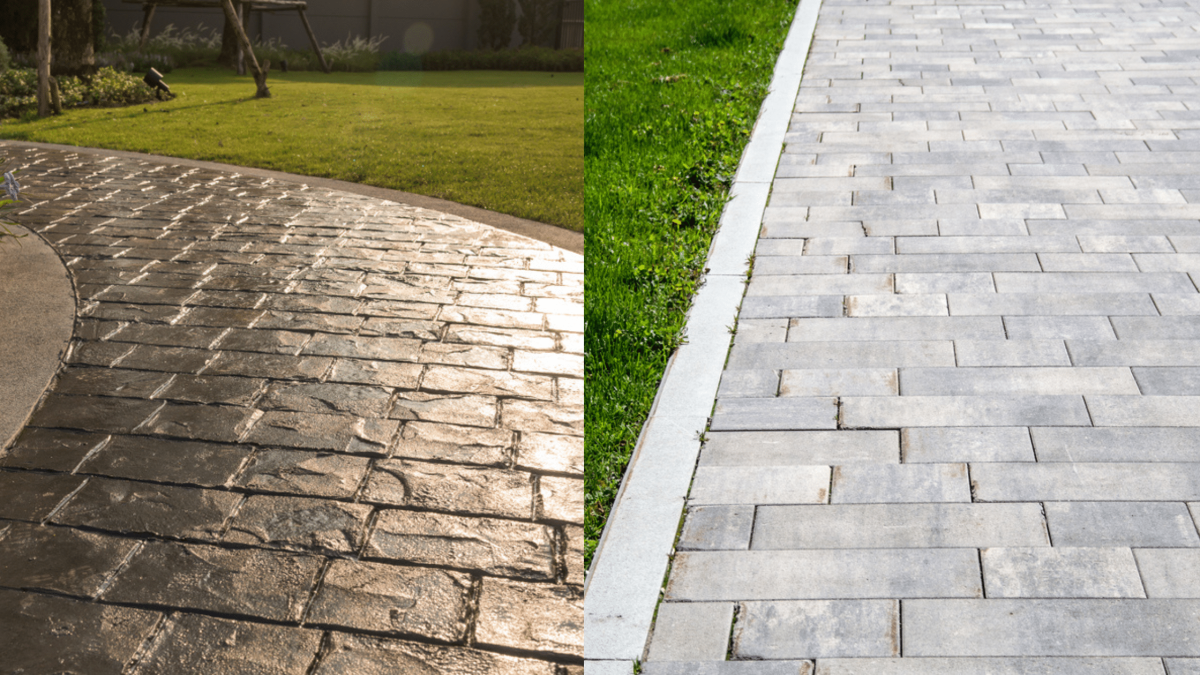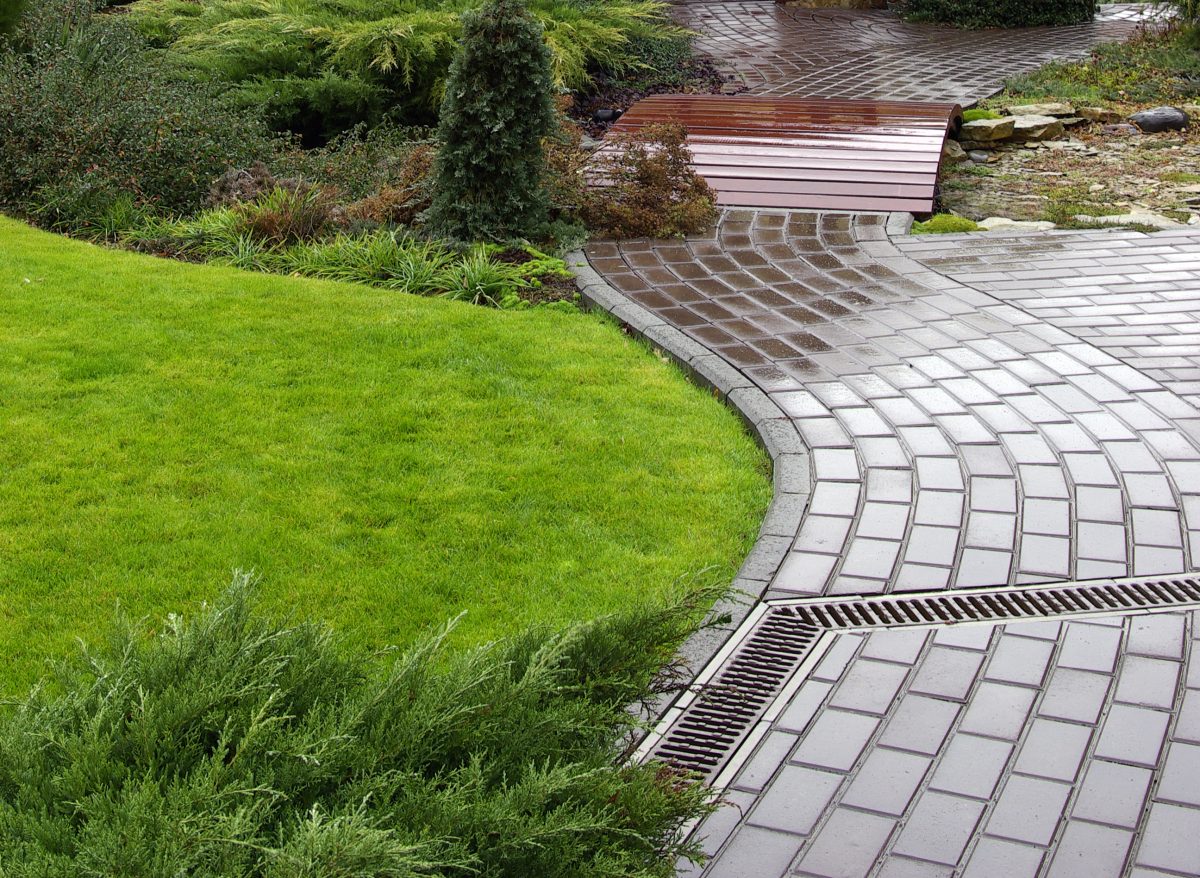
So as I see it? The choice between interlocking versus stamped really boils down to personal preference – based on factors such as budget constraints or specific design aspirations.
Understanding Interlocking and Stamped Concrete
When it comes to deciding on the right kind of pavement for your property, you’ve probably heard about two popular choices: interlocking and stamped concrete. I’m here to help demystify these options.
First off, let’s talk about interlocking concrete. This method involves using precast pieces of concrete that are designed in such a way that they fit together like puzzle pieces. They’re quite versatile and can be used in a variety of settings from driveways to patios.
On the other hand, we have stamped concrete which is essentially regular poured concrete but with an added twist – it’s embossed or textured to look like brick, stone or other patterns while still wet. Once hardened, you get an aesthetically pleasing surface that mimics more expensive materials at a fraction of the cost.
Here are some key differences between these two:
- Installation: Interlocking pavers require more labor-intensive installation compared to stamped concrete as each piece needs to be laid by hand.
- Cost: Initial costs for interlocked paving may be higher due its manual installation process.
- Maintenance & Durability: While both methods offer long-lasting durability, repairing interlock is usually easier since individual pavers can be replaced without affecting surrounding ones.
| Interlocked Paving | Stamped Concrete | |
|---|---|---|
| Installation Difficulty | Moderate-High | Low-Moderate |
| Initial Cost | High | Moderate |
| Risk Of Cracking | Low | Moderate |
Now I won’t say one option is categorically better than the other – they both have their pros and cons! It ultimately depends on factors such as budget constraints, desired aesthetic appeal and functional requirements for your specific project.
Key Differences Between Interlocking and Stamped Concrete
When it comes to choosing a paving material for your outdoor space, the decision can be daunting. You’ve got options like interlocking and stamped concrete, each with its own set of advantages. But what are the key differences between these two? Let’s delve into this.
Interlocking concrete is essentially individual units or pavers locked together to create a surface that’s strong yet flexible. The durability of this option is impressive; it stands up well against heavy traffic and harsh weather conditions without cracking or splitting due to its unique installation process. Plus, if there’s any damage down the line, you only need to replace the affected pavers instead of redoing an entire area.
On the other hand, stamped concrete mimics different textures such as brick or natural stone using specialized molds while pouring wet concrete – all in one solid piece rather than separate units like interlocking pavers. Its aesthetic appeal is undeniable; you get unlimited color choices and pattern designs offering high customization potential for homeowners who want their patios or driveways to stand out.
| Interlocking | Stamped | |
|---|---|---|
| Installation | Individual Units | One Solid Piece |
| Damage Repair | Replace Affected Paver | May Require Large Area Refinishing |
However, stamped concrete isn’t as durable as interlocked ones since cracks may develop over time due to shifting ground below – especially in climates experiencing frequent freeze-thaw cycles where ground movement tends to be more significant.
It’s also important noting that both options have varying price points:
- Interlock cost: On average, interlocking costs range from $20-$25 per square foot in Canada for 2023. This price includes both materials and labor costs.
- Stamped cost: The cost of stamped concrete can vary significantly, with prices ranging from $8-$28 per square foot on average. However, for more complex designs, the cost can go up to $45 per square foot. These prices are inclusive of labor charges.
While both types offer good return on investment by enhancing curb appeal which could boost property value substantially in long run but from budget perspective initial installation costs might play decisive role here.
In terms of maintenance too they differ quite bit:
- With interlockings – occasional resealing & filling joint sand maybe required.
- For stampeds – regular cleaning & resealing every few years would keep them looking fresh.
Now you’re armed with some vital information about these two popular paving materials! It’s crucial remembering though that ultimately best choice depends on specific project needs including budget constraints , preferred aesthetics , expected usage patterns etcetera . My hope here was just shedding light on some fundamental aspects so informed decisions can be made when time arrives .
Pros and Cons of Interlocking Concrete
When it comes to landscaping, I’ve found that one of the most versatile materials is interlocking concrete. It’s a popular choice for many homeowners, but like everything else in life, it has its pros and cons.
Starting with the positives, interlocking concrete is known for its durability. It can withstand heavy foot traffic as well as harsh weather conditions. The fact that these pavers don’t crack easily under pressure means they have a longer lifespan compared to other options like stamped concrete or asphalt.
Next up on my list of advantages are aesthetics. With interlocking pavers, you get an array of design possibilities due to their diverse shapes and colors. You’re not limited by rigid designs; instead you can create unique patterns that complement your home’s exterior décor beautifully.
On top of this, let’s talk about maintenance – another plus point for interlocking pavers! They require minimal upkeep which saves time and effort in the long run. If there’s damage or staining on any particular piece(s), you simply replace those rather than redoing entire sections!
However, nothing is without drawbacks – here are some cons associated with interlocking concrete:
First off: installation cost—it’s usually higher than other alternatives such as stamped concrete due to labor-intensive process involved during setup phase making initial investment quite hefty at times.
Another downside could be weed growth between individual blocks if proper precautions aren’t taken early on (though this issue can be mitigated through correct installation).
Here’s a quick summary:
| Pro/Con | Detail |
|---|---|
| Pro | Durable against traffic & weather |
| Pro | Aesthetically flexible |
| Pro | Low Maintenance |
| Con | Higher Installation Cost |
- Con : Possible Weed Growth
In conclusion , whether or not interlocked paving fits your needs will largely depend upon factors like budget constraints , aesthetic preferences & maintenance commitment levels .
Pros and Cons of Stamped Concrete
Let’s dive into the pros and cons of stamped concrete, a popular choice among homeowners looking to elevate their outdoor spaces.
One significant advantage is versatility. With stamped concrete, I can replicate virtually any material — from brick and slate to wood. It provides an incredible range of design options that can fit seamlessly with any landscape or architectural style.
Next up is its cost-effectiveness compared to natural stone or pavers. While initial costs might be higher than plain concrete, it’s definitely more affordable in the long run due to reduced maintenance needs.
Here’s a quick comparison:
| Material | Initial Cost | Long-term Maintenance Cost |
|---|---|---|
| Stamped Concrete | Medium-High | Low-Medium |
| Natural Stone/Pavers | High | High |
Stamped concrete also scores high on durability. It stands up well against weather extremes – whether it’s freezing temperatures or scorching heat waves – making it a reliable choice for outdoor applications.
Now let’s switch gears and look at some potential drawbacks.
A key concern with stamped concrete is that it can become slippery when wet if not properly sealed or textured during installation – posing risks especially around pool areas.
Another downside: over time, heavy loads (like large vehicles) could cause cracking unless reinforcement measures are taken during installation.
Lastly, unlike paver systems where you can easily replace individual units if damaged, repairing cracked or chipped stamped concrete involves more complex procedures which may lead to color mismatch issues – affecting overall aesthetics.
To sum things up:
- Pros:
- Versatile design
- Cost-effective
- Durable
- Cons:
- Can be slippery when wet
- Potential for cracks under heavy load
- Difficult repairs
Choosing between interlocking vs stamped concrete ultimately depends on personal preferences and specific project requirements.
Making the Choice: Interlocking vs. Stamped
When it comes to choosing between interlocking and stamped concrete for a project, there’s quite a bit to consider. I’ve found that understanding the pros and cons of each is essential in making an informed decision.
Interlocking pavers offer several advantages:
- They’re available in various colors, shapes, and sizes
- The installation process allows for quick repairs if necessary
- There’s increased flexibility as they can move with the earth without cracking
However, they also have their downsides:
- Weeds can grow between the joints over time
- The initial cost is typically higher than other options
- Maintenance involves regular sealing or replacing chipped pavers
On the other hand, stamped concrete presents its own set of benefits:
- It replicates other materials like brick or stone at a lower cost
- It has low maintenance needs once sealed properly
- Its seamless surface means no weeds
But it isn’t perfect either:
- Cracking may occur due to ground movement
- Repairs are more noticeable and challenging than interlocking pavers
- Color might fade over time requiring resealing or recoloring
For me personally? I lean towards using interlocking when clients want versatility in design and don’t mind maintaining their landscape. However, if they’re looking for lower maintenance costs while still achieving a high-end look—stamped concrete often becomes my go-to recommendation.
So there you have it! Both options provide unique advantages depending on your project’s specific needs. By weighing these factors carefully against your budget constraints and personal style preferences—you’ll find yourself well-equipped to make this critical choice!
Troy Channer is a seasoned professional with over a decade of experience in the construction industry, specializing in residential projects and road infrastructure networks. His expertise spans a broad range of skills, including proficiency in Microsoft Excel, Word, and PowerPoint, which he adeptly uses to streamline operations and enhance productivity.
Troy’s commitment to excellent customer service is a cornerstone of his professional philosophy, always prioritizing client satisfaction and fostering strong relationships. His leadership skills are well-recognized, and he has a proven track record of managing teams to deliver high-quality results.
In addition to his construction experience, Troy is also the proud owner of a successful landscape company based in Oakville. This venture allows him to apply his extensive knowledge of civil engineering and project management to create beautiful and sustainable outdoor spaces for his clients.
Troy holds an Advanced Diploma in Civil Engineering Technology from Humber College, further solidifying his credentials as a highly skilled operations professional in the industry. His combined experience and education make him a versatile professional capable of tackling a wide range of projects.










